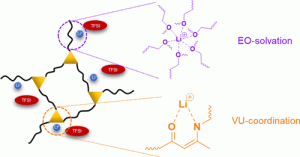 Polymers with dynamic bonds connecting the chains are a promising class of material for recycling, sustainability, self-healing, and multifunctionality. Our group is focused on understanding how the exchange of strands in polymer networks impacts a diverse array of properties including viscosity, modulus, crystallinity, self-assembly, energy dissipation, coatings, conductivity, and penetrant transport. The additional dynamics introduced by bond exchange can have massive impacts on the resulting performance of polymer networks, and points to new mechanisms for improving the functionality of soft materials. We focus mostly on dynamic bonds which do not dissociate during the exchange process (like hydrogen bonds), but rather keep the network intact. Connecting the molecular scale chemistry to macroscopic properties is a key aim of our research.
Polymers with dynamic bonds connecting the chains are a promising class of material for recycling, sustainability, self-healing, and multifunctionality. Our group is focused on understanding how the exchange of strands in polymer networks impacts a diverse array of properties including viscosity, modulus, crystallinity, self-assembly, energy dissipation, coatings, conductivity, and penetrant transport. The additional dynamics introduced by bond exchange can have massive impacts on the resulting performance of polymer networks, and points to new mechanisms for improving the functionality of soft materials. We focus mostly on dynamic bonds which do not dissociate during the exchange process (like hydrogen bonds), but rather keep the network intact. Connecting the molecular scale chemistry to macroscopic properties is a key aim of our research.
 Our group is also interested in the role of ionic charges on polymer physics. This includes understanding how charged macromolecules diffuse, how salt impacts dynamic bond exchange kinetics, and the ability of ionic groups to introduce new dynamic processes into polymers for energy dissipation. Most of our studies use bulky, delocalized charges which lead to weak electrostatic interactions and novel properties. The role of bond exchange on conductivity is also being explored for dense networks with fast dynamic bond exchange. Such dynamic network electrolytes have the added benefit of being recyclable and self-healing.
Our group is also interested in the role of ionic charges on polymer physics. This includes understanding how charged macromolecules diffuse, how salt impacts dynamic bond exchange kinetics, and the ability of ionic groups to introduce new dynamic processes into polymers for energy dissipation. Most of our studies use bulky, delocalized charges which lead to weak electrostatic interactions and novel properties. The role of bond exchange on conductivity is also being explored for dense networks with fast dynamic bond exchange. Such dynamic network electrolytes have the added benefit of being recyclable and self-healing.
 Macromolecules like peptides can form secondary structures such as alpha helices. While helices have been well studied in biological contexts or in solution, much less is known about the role of secondary structure on dry polymer properties. We have shown that a helical backbone can promote ionic conductivity relative to a random coil, and that secondary structure is a powerful concept for solid electrolytes. We are currently probing how a helical polymer backbone impacts other key properties such as chain diffusion and network elasticity. Solid state peptide materials are a promising platform for functional materials, particularly when combined with dynamic bonding concepts.
Macromolecules like peptides can form secondary structures such as alpha helices. While helices have been well studied in biological contexts or in solution, much less is known about the role of secondary structure on dry polymer properties. We have shown that a helical backbone can promote ionic conductivity relative to a random coil, and that secondary structure is a powerful concept for solid electrolytes. We are currently probing how a helical polymer backbone impacts other key properties such as chain diffusion and network elasticity. Solid state peptide materials are a promising platform for functional materials, particularly when combined with dynamic bonding concepts.